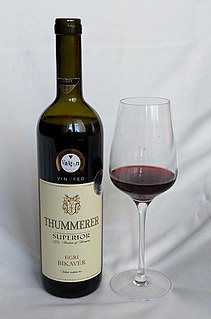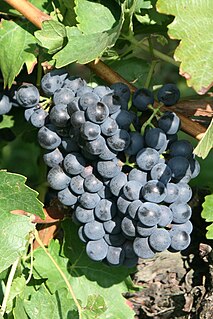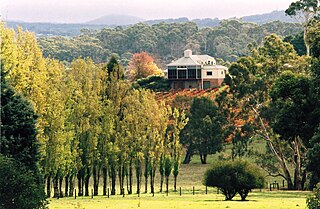Related Research Articles

Austrian cuisine is a style of cuisine native to Austria and composed of influences from Central Europe and throughout the former Austro-Hungarian Empire. Austrian cuisine is most often associated with Viennese cuisine, but there are significant regional variations.

Grüner Veltliner is a white wine grape variety grown primarily in Austria, Hungary, Slovakia, and the Czech Republic. The leaves of the grape vine are five-lobed with bunches that are long but compact, and deep green grapes that ripen in mid-late October in the Northern Hemisphere.

The Zweigelt is a new Austrian grape created in 1922 by Friedrich Zweigelt (1888–1964), who later became Director of the Federal Institute and Experimental Station of Viticulture, Fruit Production and Horticulture (1938–1945). It comprises a crossing between St. Laurent and Blaufränkisch.

Blaufränkisch is a dark-skinned variety of grape used for red wine. Blaufränkisch, which is a late-ripening variety, produces red wines which are typically rich in tannin and may exhibit a pronounced spicy character.
Rotberger is a wine grape variety. Its parentage is not known with certainty but it is thought to be from a cross of Trollinger and Riesling grapes. Dr. Heinrich Birk (1898-1973) produced the cross at the Geisenheim Grape Breeding Institute in 1928. It is used to produce fruity, early maturing light red wines in cool-climate areas. It is often best drunk when young and can be used to produce a rosé or sparkling wine. It has no relationship with the Rotburger variety bearing a nearly similar name which is also known as Zweigelt.
Hungarian wine has a history dating back to the Kingdom of Hungary. Outside Hungary, the best-known wines are the white dessert wine Tokaji aszú and the red wine Bull's Blood of Eger.

Welschriesling is a white wine grape variety, unrelated to the Rhine Riesling, that is grown throughout Central Europe.

Egri Bikavér is a blended red wine produced in Eger, Hungary. It is very representative of the red wines of Eger, a terroir wine, which carries the flavour of the soils of local production sites, the mezzo-climate unique to the region and the traditions and mores of local residents, from the selection of varieties to choosing the period and method of grape processing and mellowing.

Sylvaner or Silvaner is a variety of white wine grape grown primarily in Alsace and Germany, where its official name is Grüner Silvaner. While the Alsatian versions have primarily been considered simpler wines, it was recently (2006) included among the varieties that can be used to produce Alsace Grand Cru wine together with the four 'noble grapes' of Alsace, although only in one vineyard, Zotzenberg.

St. Laurent is a highly aromatic dark-skinned wine grape variety. Its origins shrouded in mystery, St. Laurent is believed to have resulted from a crossing of Pinot noir with an unknown second parent.

Blauer Portugieser is a red Austrian, Slovenian wine and German wine grape found primarily in the Rheinhessen, Pfalz and wine regions of Lower Austria and Slovenia. It is also one of the permitted grapes in the Hungarian wine Egri Bikavér. In Germany, the cultivated area covered 4,551 hectares or 4.5% of the total vineyard area in 2007. Wine cellars usually vinify a simple light red wine, which is characterized by a fresh, tart and light body. It is also frequently vinified as a rosé. Blauer Portugieser is also very well suited as table grapes; however, it is not sold as such because the selling of wine grapes as table grapes is not permitted in the European Union. Since 2000, higher quality wines have been vinified from Portugieser grapes. The use of oak provides additional aromas in order to compete with Bordeaux varieties. DNA profiling has shown that Blauer Portugieser is a cross between Grüner Silvaner and Blaue Zimmettraube. Historical ampelographic sources have provided very solid evidence that the geographic area of origin of the variety is Lower Styria.

Austrian wines are mostly dry white wines, though some sweeter white wines are also produced. About 30% of the wines are red, made from Blaufränkisch, Pinot noir and locally bred varieties such as Zweigelt. Four thousand years of winemaking history counted for little after the "antifreeze scandal" of 1985, when it was revealed that some wine brokers had been adulterating their wines with diethylene glycol. The scandal destroyed the market for Austrian wine and compelled Austria to tackle low standards of bulk wine production, and reposition itself as a producer of quality wines. The country is also home to Riedel, makers of some of the most expensive wine glasses in the world. Some of the best producers of Austria include Weingut Bründlmayer, Weingut F.X. Pichler and Weingut Franz Hirtzberger, Weingut Hutter, Weingut Eigl and Wellanschitz.
Friedrich (Fritz) Zweigelt was an Austrian entomologist and phytologist. Zweigelt was one of the most influential and internationally renowned figures in Austrian wine growing between 1921 and 1945. He was Head of State Vine Cultivation during the period of the First Austrian Republic and also acted as Director of the School of Viticulture and Horticulture in Klosterneuburg near Vienna. The grape variety "Blauer Zweigelt" is named after him. Blauer Zweigelt is grown across an area of some 6,400 hectares in Austria, making it by far the most significant red wine grape cultivated in the country. Zweigelt's National Socialist sympathies and activities did not come to the attention of the public for some decades.

Mailberg is a town in the district of Hollabrunn in Lower Austria, Austria. First mentioned in records in 1055 Castle Mailberg is owned and run by the Austrian Grand Priory of the Sovereign Military Order of Malta since 1146. It is known for its wine production and now serves as a castle hotel and as Vinothek for the local Winemakers Community "Mailberg Valley".

Hitzendorf is a municipality in the district of Graz-Umgebung in the Austrian state of Styria.

Zierfandler is a grape variety used to make white wine in the Thermenregion of Austria. It is also known as Spätrot because it turns red just before harvest time. It is traditionally blended with Rotgipfler but is increasingly being sold as a varietal wine. Zierfandler wines are typically elegant and quite sweet, but with much balancing acidity and a nutty bouquet of pistachios and almonds. They are capable of ageing well.

Slovenian wine is wine from Slovenia. Viticulture and winemaking has existed in this region since the time of the Celts and Illyrians tribes, long before the Romans would introduce winemaking to the lands of France, Spain and Germany.
Goldburger is a white Austrian wine grape grown primarily in the Burgenland region. The grape is a crossing of Orangetraube and Welschriesling and was created in 1922 by Fritz Zweigelt at the Höhere Bundeslehranstalt und Bundesamt für Wein- und Obstbau (HBLAuBA) in Klosterneuburg.

The Dealu Mare wine region is located within the Muntenia area of Romania. It is located around Valea Călugărească commune in Prahova County, best known for its red wines, and the Pietroasele commune in Buzău County, best known for white wines. Typically identified as one of the most important wine regions in Romania, it encompasses about 400 square kilometres under the Southern Carpathians.

Hahndorf Hill Winery, also known as HHW, is a boutique vineyard situated adjacent to the historic, German-heritage village of Hahndorf, South Australia, in the Adelaide Hills wine region.
References
- ↑ "Blauburger". Vitis International Variety Catalogue . Archived from the original on 2012-04-05. Retrieved 2010-02-04.
- ↑ Ganesch, Julius Kühn-Institut (JKI), Federal Research Centre for Cultivated Plants, Institute for Grapevine Breeding, Geilweilerhof ,Siebeldingen, Erika Maul, Reinhard Töpfer, Rudolf Eibach, Alina. "Area tabular listing". www.vivc.de. Retrieved 2017-02-14.